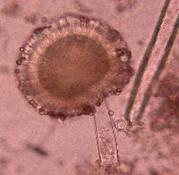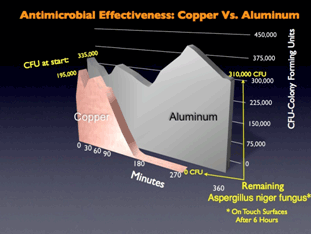 Aspergillus niger
Aspergillus nigerThe Copper Air Quality Program will test the applicability of previous laboratory work, first in an indoor air quality laboratory and then in a field environment to demonstrate that:
- The introduction of copper components in HVAC systems will reduce the levels of harmful microbes that could potentially colonize in the system.
- HVAC systems fitted with copper components (coils, fins, condensate drain pans, etc.) will perform comparably and operate more efficiently than similar aluminum systems that utilize ultraviolet lighting or other sanitizing means to reduce harmful microbes.
- Reducing the levels of dangerous microbes in HVAC systems will result in improved indoor air quality and help protect human health and well-being.
- HVAC systems fitted with copper components can be deployed in a variety of enclosed environments, including hospitals, submarines, aircraft and spacecraft.
- The antimicrobial effects of copper will augment current HVAC maintenance practices and help to reduce the potential for contaminated systems to become breeding grounds for biological contaminants — including bacteria, fungi (mold, mildew), viruses and microbial spores that are a health risk to humans.

This program is based upon work supported by the U.S. Army Medical Research and Materiel Command under Contract No. W81XWH-07-C-0054. Any opinions, findings and conclusions or recommendations expressed in this material are those of the author(s) and do not necessarily reflect the views of the U.S. Army Medical Research Acquisition Activity.
